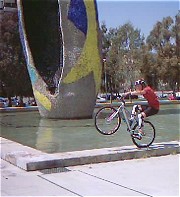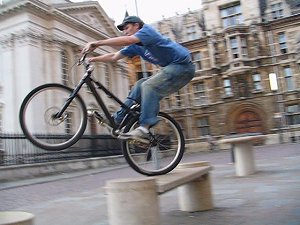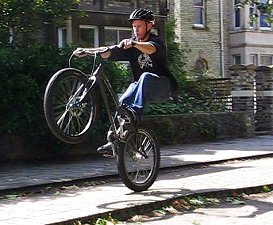 Wheelings and manuals
Wheelings and manuals
A classic for urban riders. A good exercise for balance, can't be bad for overall control skills.
Starting a wheeling
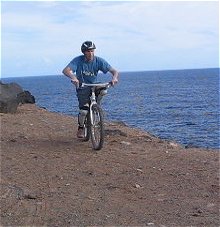
1° Moving slowly, start on your good pedal, then follow up with an acceleration in your wrong pedal to lift the front wheel while seated. Push-up on the bars just before pulling backwards.
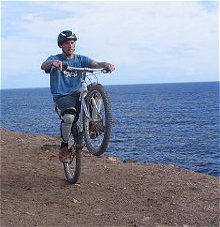
2° Pull back your shoulders as far as possible, with the arms extended and carry on lifting the front wheel until you reach balance on the rear (before falling backwards)
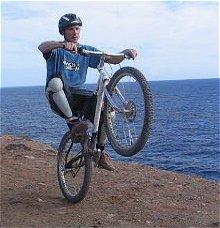
3° Keeping the knees very loose, carry on pedaling slowly. If you tend to accelerate too much, use the brakes slightly so that you don't fall on your back, else push more on the pedals.
See this move in a video You should find a point of balance where you just keep the bike rolling without accelerating. Adjust your balance with the hips. It is easier to learn going up a very smooth slope, then you don't need to control so much the brakes.
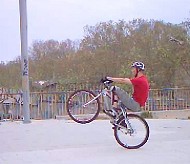
Maintain the wheeling
without accelerating.
Wrong debut
At the beginning, if the front wheel tends to drop, it is because you are not enough leaning backwards.
For the wheeling, you should reach and feel exactly the same point sitting on your bike, as if you were balancing on
a normal chair, on two legs only. Then, when the front wheel drops, a slight pedal acceleration or just pulling your
shoulders backwards to reajust your balance. If you fall too much backwards, then you can either crouch forward while
folding the arms, or use the rear brakes slightly to stay in balance. The mistake of most beginners is to do wheelings
by only pedaling and accelerating constantly, instead of finding the right balance. If you can't lift the front wheel at
all, it is because your keep too much weight on the front of the bike. By putting your weight over the rear wheel (nearly
sitting on the rear tire), the bike will naturally want to lift the front wheel. To get the move, try to pull so much behind
the seat that you fall off the back. From there, adjust the pull.
Lateral balance
Once the front wheel lifted, to keep going straight without falling sideways, you must use your knees and waist.
For example, if you fall on the left, pull the right knee on the right outside, and if necessary, while seated,
move the waist a bit aside. You can open the knees more or less, and have perfect lateral control, then you must control
the vertical balance with the shoulders and arms. Really start a low speed and try not to accelerate to keep a constant
speed. Eventually, you'll be able to roll slowly, slow down and carry on again. It really takes some practice but its worth
the feel. For the braking control, you can practice wheelings down a slight slope, without pedalling (manual) but only
adjusting your speed by braking. To compensate for the braking torque that pulls the front wheel down, lean more backwards
as you brake.
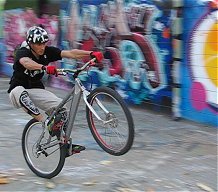
Manual: balance with the knees.
The Manual
The 'Manual' is a variant of the wheeling where you carry on rolling without pedalling, while standing.
For the manuals, some good pedal strokes for the speed, then lift the front wheel and stay in balance on the rear wheel.
Keep your bum above the rear wheel axis and control the whole bike inclination with your arms and knees.
In a very well balanced manual, you don't even need to touch the brakes. Then a bit more complicated, is to land a bunny hop directly in manual (instead of a blunt stop) to carry on rolling smoothly on top of an obstacle. This brings a more urban BMX style to trials, stylish although never ever used in time trials. But hey, let's have fun too. This move requires excellent balance control, as you have to roll perfectly over the step you climb (while avoiding a crash on your back). Keep a finger ready on the rear brakes, just in case.








